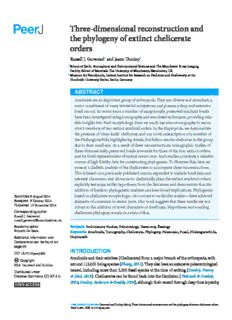Table Of ContentThree-dimensional reconstruction and
the phylogeny of extinct chelicerate
orders
RussellJ.Garwood1 andJasonDunlop2
1SchoolofEarth,AtmosphericandEnvironmentalSciencesandTheManchesterX-rayImaging
Facility,SchoolofMaterials,TheUniversityofManchester,Manchester,UK
2Museumfu¨rNaturkunde,LeibnizInstituteforResearchonEvolutionandBiodiversityatthe
HumboldtUniversityBerlin,Berlin,Germany
ABSTRACT
Arachnidsareanimportantgroupofarthropods.Theyare:diverseandabundant;a
majorconstituentofmanyterrestrialecosystems;andpossessadeepandextensive
fossilrecord.Inrecentyearsanumberofexceptionallypreservedarachnidfossils
havebeeninvestigatedusingtomographyandassociatedtechniques,providingvalu-
ableinsightsintotheirmorphology.HereweuseX-raymicrotomographytorecon-
structmembersoftwoextinctarachnidorders.IntheHaptopoda,wedemonstrate
thepresenceof‘clasp-knife’chelicerae,andournovelredescriptionofamemberof
thePhalangiotarbidahighlightslegdetails,butfailstoresolvecheliceraeinthegroup
duetotheirsmallsize.Asaresultofthesereconstructions,tomographicstudiesof
three-dimensionallypreservedfossilsnowexistforthreeofthefourextinctorders,
andforfossilrepresentativesofseveralextantones.Suchstudiesconstituteavaluable
sourceofhighfidelitydataforconstructingphylogenies.Toillustratethis,herewe
presentacladisticanalysisofthecheliceratestoaccompanythesereconstructions.
Thisisbasedonapreviouslypublishedmatrix,expandedtoincludefossiltaxaand
relevantcharacters,andallowsusto:cladisticallyplacetheextinctarachnidorders;
explicitlytestsomeearlierhypothesesfromtheliterature;anddemonstratethatthe
additionoffossilstophylogeneticanalysescanhavebroadimplications.Phylogenies
Submitted8August2014 basedoncheliceratemorphology—incontrasttomolecularstudies—haveachieved
Accepted 8October2014 elementsofconsensusinrecentyears.Ourworksuggeststhattheseresultsarenot
Published 13November2014
robusttotheadditionofnovelcharactersorfossiltaxa.Hypothesessurrounding
Correspondingauthor cheliceratephylogenyremaininastateofflux.
RussellJ.Garwood,
[email protected]
Academiceditor Subjects EvolutionaryStudies,Paleontology,Taxonomy,Zoology
KennethDeBaets Keywords Arachnida,Tomography,Chelicerata,Phylogeny,Palaeozoic,Fossil,Phalangiotarbida,
AdditionalInformationand Haptopoda
Declarationscanbefoundon
page26
INTRODUCTION
DOI10.7717/peerj.641
Arachnidsandtheirrelatives(Chelicerata)formamajorbranchofthearthropods,with
Copyright
2014 GarwoodandDunlop around112,000livingspecies(Zhang,2011).Theyalsohaveanextensivepalaeontological
record,includingmorethan2,200fossilspeciesatthetimeofwriting(Dunlop,Penney
Distributedunder
CreativeCommonsCC-BY4.0 &Jekel,2014).CheliceratescanbefoundbackintotheCambrian(Waloszek&Dunlop,
2002;Dunlop,Anderson&Braddy,2004),althoughtheirrecordthroughdeeptimeispatchy
OPENACCESS
HowtocitethisarticleGarwoodandDunlop(2014),Three-dimensionalreconstructionandthephylogenyofextinctchelicerateorders.
PeerJ2:e641;DOI10.7717/peerj.641
andtendstobeconcentratedintowindowsofexceptionalpreservationsuchasthelate
CarboniferousCoalMeasuresandvariousCretaceousandCenozoicambers.Currently,
sixteenarachnidorderscanberecognised.Twelvehavelivingrepresentatives:scorpions
(Scorpiones), harvestmen (Opiliones), pseudoscorpions (Pseudoscorpiones), camel
spiders(Solifugae),palpigrades(Palipgradi),mites(AcariformesandParasitiformes),
ricinuleids(Ricinulei),spiders(Araneae),whipspiders(Amblypygi),whipscorpions
(Thelyphonida)andschizomids(Schizomida).Fourarachnidordersareextinct:trigono-
tarbids(Trigonotarbida),phalangiotarbids(Phalangiotarbida),haptopodids(Haptopoda)
andthespider-likeuraraneids(Uraraneida).Tothiscanbeaddedtwomarinegroupswith
livingrepresentatives,theseaspiders(Pycnogonida)andhorseshoecrabs(Xiphosura),
aswellastwoextinctgroupswhichwerelikelytohavebeenprimarilyaquatic,thesea
scorpions(Eurypterida)andtherarechasmataspidids(Chasmataspidida).
Resolvingrelationshipsbetweenthearachnidand/orcheliceratelineagesremainsa
challenge.Importantcladisticstudiesincludethecomprehensivemorphologicalanalyses
ofWeygoldt&Paulus(1979),Shultz(1990)andShultz(2007),aswellasnumerousapplica-
tionsofmoleculardata—sometimeswithmorphologycombined(e.g.,Wheeler&Hayashi,
1998;Giribetetal.,2002;Pepato,daRocha&Dunlop,2010;Rehmetal.,2011).Fewofthese
includefossilterminals(butseeGiribetetal.,2002;Shultz,2007)—despitethefactthat
extinctspeciesprovideavaluablesourceofdata(Edgecombe,2010).Severalarthropod-
wideanalyses—bothmolecularandmorphological—alsoincludechelicerates(Regieret
al.,2010;Legg,Sutton&Edgecombe,2013;Rota-Stabelli,Daley&Pisani,2013).Yet,asnoted
inarecentreview(Dunlop,Borner&Burmester,2014),thereisstillnosingleaccepted
phylogenyforarachnidsandtheirrelatives,andthereareevidentdiscrepanciesbetween
treesderivedfrommorphologicalandmoleculardata.Dunlop,Borner&Burmester(2014)
thusrecognisedaminimumconsensustree,i.e.,supportedbyvariousmethodologies,
oftheform(Pycnogonida(Xiphosura(Scorpiones(Araneae(Amblypygi(Thelyphonida
+Schizomida)))))).Thisratherextensivelyprunedphylogenystillexcludesdiverseand
importantgroupslikemites,harvestmenandpseudoscorpions,anddoesnotplaceany
ofthefossiltaxa.Xiphosurawasrecentlyinterpretedasparaphyletic(Lamsdell,2013),at
leastwithrespecttoPalaeozoic‘synziphosurines’whichmayincludelineageseventually
evolvingintobothcrown-grouphorseshoecrabsand,separately,intoarachnids.
Fossilshavesometimesprovedcontroversialinphylogeneticreconstruction,andfor
arachnidssomeauthorssimplyexcludedthemcompletely(e.g.,Wheeler&Hayashi,1998).
Extincttaxaofferdirectevidenceofearly—andpossiblyquitedifferent—bodyplans,but
oftenhavelargeamountsofmissingdatawhencomparedtolivingtaxa.Furthermore,
scoringmorphologicalcharacterstatesinfossilsinvolvesadegreeofinterpretation,and
objectiveinferenceshavetobemade.Despitethechallengesinherentinusingfossilsin
suchanalyses,recentstudieshavedemonstratedtheutilityandimportanceofdoingsoin
arangeofdifferentanalyses(Legg,Sutton&Edgecombe,2013;Sharma&Giribet,2014).
Furthermore,inrecentyearsthelevelofinterpretationrequiredhasbeenreducedthrough
anumberofimprovementsinourunderstandingoffossilarachnid(andarthropod)data.
Forexample,theapplicationofvarioustechniquessuchasX-raycomputedtomography—
GarwoodandDunlop(2014),PeerJ,DOI10.7717/peerj.641 2/33
especiallymicrotomography(µCT,e.g.,Garwood,Dunlop&Sutton,2009)—hasallowed
theanatomyofsomefossilstobereconstructedinunparallelledthree-dimensionaldetail.
ForareviewofsuchmethodologiesseeSutton,Rahman&Garwood(2014).
Theprincipalaimofthisstudyistodrawtogetherrecentlypublishedexamplesofwell-
preservedand(wherepossible)three-dimensionallyreconstructedfossilsinaphylogenetic
analysis,andtoaugmentthesewithnoveldatafortwoextinctarachnidorders:Phalangio-
tarbidaandHaptopoda.Ourintentionisnottopresentafullyresolvedphylogenetictree,
andwedonotconsiderthetopologyrecoveredthesolesolutiontoarachnidphylogeny.
Rather,weuseittoidentifycommontrendsandexploretheimpactoffossildataontree
topologieswhenscoredintoanmodifiedversionofapreviouslypublisheddataset.In
additiontotwenty-sevennewlyaddedfossiltaxa,thematrix—whichisamendedfromthat
ofPepato,daRocha&Dunlop(2010)—hassixteennewcharacterstocapturethefullest
possiblerangeoffossilmorphology.Thisexerciseallowsustoassesshowrobusttheplace-
mentofextincttaxais,howtheseimpactontherelationshipsrecoveredbetweenextant
groups,andtoexplicitlytestsomeearlierhypothesesfromtheliterature.Wealsohope
thatourmatrixwillconstituteastartingpointforfurtherstudies,andprovideauseful
contributionintowhichnewfossildiscoveriescanbeintegrated.Followingmaterialsand
methodsinformation,wepresentfirsttheresultsofourtomographicreconstructions,and
thenresultsanddiscussionforourcladisticanalysis.Wesubsequentlydiscusstheimpactof
fossils.CharacterdescriptionsareincludedasSupplementalInformation.
MATERIALS AND METHODS
Material and tomography
Alltomographicreconstructionspresentedinthecurrentstudyarebasedonmaterialfrom
theCoseleyLagersta¨tte,nearDudley,Staffordshire,UK.TheyarethusLateCarboniferous,
from the similis–pulchra zone of the British Middle Coal Measures; Duckmantian
in age (ca. 315 Ma; Pointon et al., 2012), or Westphalian B using more traditional
terminology.Theirpreservationisasthree-dimensionalvoids—somepartiallyinfilled
withkaolinite—withinsideritenodules.ScanswereconductedattheNaturalHistory
Museum,LondononaNikonHMX-ST225scannerwithatungstenreflectiontarget.
Two specimens of Plesiosiromadeleyi (NHM I. 15899, NHM I. 7923) from the
(monotypic)extinctorderHaptopodawerescanned.Theywereselectedasthemost
three-dimensionalrepresentativesofalltheNHMspecimensofthisspecies,andNHM
I.7923waschosenforsubsequentprocessingasthemostcompleteexample.Thiswas
scannedat180kV/175µA,witha0.25mmcopperfilter,and3,142projectionsofexposure
354ms,toprovideareconstructeddatasetwitha19.5µmvoxelsize.
Materialfromtwospeciesofanotherextinctorder,Phalangiotarbida,werescanned.
One was not well-preserved enough to justify further reconstruction: Goniotarbus
tuberculatas (BU 696, Lapworth Museum Birmingham, also Coseley). However, the
NHMspecimenIn22,838,theholotypeofGoniotarbusangulatus,wasbetterresolved,
andrevealedimportantlimbmorphology.ItwaslastdescribedbyPetrunkevitch(1953)
whoseworkhas,inthepast,necessitatedsignificantrevision(e.g.,Dunlop,1996a;Garwood
GarwoodandDunlop(2014),PeerJ,DOI10.7717/peerj.641 3/33
&Dunlop,2011).Accordinglythisphalangiotarbidspecimenwasselectedforfurther
processing.Thescanwasconductedat225kV/190µA,andwithoutaddedfiltration.3,142
projectionsofexposure180mswerecollected,andareconstructeddatasetwitha16.0µm
voxelsizecreated.
Digital visualisation
Bothscanswereusedtocreatethree-dimensional,virtualfossilsusingthecustomSPIERS
softwaresuite(Suttonetal.,2012)followingthemethodsofGarwoodetal.(2012).The
distallimbsofPlesiosiromadeleyiwerenotrecoveredbythescanwheretheyweretruncated
bytheedgeofthenodule.SeveralofthewalkinglegsofGoniotarbusangulatuswereabsent.
Bothmodelswerescaled,andthenexportedtobepresentedhereasVAXMLmodels
(FileS1).SPIERS-generatedisosurfaceswerethenray-tracedinBlenderforfiguresand
videos (Garwood & Dunlop, 2014)—for Goniotarbusangulatus enough of the limbs
werepreservedtoallowmissingelementstobemanuallymodelledfromthosepresent.
ThiswasachievedinBlender,andtheaddedelementsarerenderedsemi-transparentfor
clarity(Fig.1).
Microscopy
HandspecimenphotographsofPlesiosiromadeleyiareavailableintheredescriptionof
Dunlop(1999).NocomparablemodernphotographsofGoniotarbusangulatusexist.Ac-
cordinglyaplateofhandspecimenphotographsispublishedhereinshowingtheholotype,
andonlyknownspecimen(NHMIn22838:Fig.2).Thiswasstudiedandphotographed
usingaLeicaMZ16Astereomicroscopeandincidentlight.Photographstakenatmultiple
focaldepthswerecombinedusingthesoftwareCombineZM(seeBercovici,Hadley&
Villanueva-Amadoz,2009).Photographsofthewholefossil—whichwastoolargeforthe
fieldofview—werecreatedbymanuallystitchingsectionsusingtheopensourceraster
graphicseditorGIMP2.8,andfigureswereassembledinInkscape0.48.Forcomparative
purposesspecimensofarelatedspecies(Petrunkevitch,1949),Goniotarbustuberculatus
(NHMIn31249,NHMIn18340,andNHMIn22840),werealsostudied.
Character coding
Thecurrentanalysisof86taxaand192charactersisamodifiedversionof‘MatrixA’
createdbyPepato,daRocha&Dunlop(2010).Aparticularfocusofthepreviousstudywas
toclarifythepositionof,andrelationshipswithin,themites.Consequentlytheanalysis
hadalargenumberofmite-specificcharacters.Thecurrentstudyhasdifferentgoals,and
foreaseofanalysisandclarityweexcludenumerouscharacterswhichareonlyhelpful
forresolvingingrouprelationshipswithinoneorbothofthetwomajormitelineages
(i.e.,acariformsandparasitiforms).Weremovetwofurthercharactersbaseduponthe
reviewsofthecurrentmanuscript,whichareavailablewiththispaper.Inadditiontothese
changes,weadded16charactersrelevantforfossiltaxa,andmodifiedotherstomakethem
applicabletonewlyintroducedfossilterminals.Examplesofnovelcharactersinclude:a
prosomalshieldwithameso-andmetapeltidiumdemarcated;thepresenceofgenalspines;
theprosomaandopisthosomaformingasinglefunctionaltagma;‘elbowed’cheliceraein
GarwoodandDunlop(2014),PeerJ,DOI10.7717/peerj.641 4/33
Figure 1 Digital visualisations of the haptopod Plesiosiro madeleyi (NHM I7923; (A)–(D)), and
phalangiotarbid Goniotarbus angulatus (NHM In 22838; (E)–(I)). (A) Dorsal view of P. madeleyi,
showingopisthosomalsegmentationandprosomalshieldarchitecture.(B)Lateralviewoftheanterior
ventral prosoma, nearest limbs and lateral prosoma removed, showing the nature of haptopod che-
licerae.(C)Ventralview,showingventralsegmentation,anddividedsternum.(D)Haptopodwalking
leg. (E) First left walking leg of G. angulatus, showing typical segmentation. (F) Lateral view of the
anteriorventralprosoma,showingthesmallpedipalps,medianridge,andpossiblechelicerae—below
theresolutionofthescan.(G)Fourthrightwalkingleg.(H)Dorsalviewshowingmedianeyesanddorsal
opisthosomal segmentation. (I) Ventral view showing opisthosomal segmentation and coxo-sternal
region.Abbreviations:1–10,opisthosomalsegmentnumber;as,anteriorsclerite;ch,chelicerae;cx,coxa;
fa,fang;fe,femur;L1–L4,walkinglegs1–4;me,mediaeyes;mt,metatarsus;pa,paturon;pp,pedipalps;
ps, pofsterior sclerite; pt, patella; ta, tarsus; ti, tibia; tr, trochanter. Scale bars: (A, C, F–I) = 3 mm;
(B,D,E)=1mm.
GarwoodandDunlop(2014),PeerJ,DOI10.7717/peerj.641 5/33
Figure2 HolotypeandonlyknownspecimenofphalangiotarbidGoniotarbusangulatus(NHMIn
22838).(A)Dorsalview,showingprosomaandopisthosoma,andlegs4Land2L.Proximalportionsof
Leg1Larevisibleattheanteriorofthefossil,asarethetrochantersofseveralofthelegsontheright.
(B)Ventralviewshowingcoxo-sternalarrangementandventralopisthosomalsegmentation.Proximal
portions of Leg 1L, then 2L 3L and 4L are visible. (C) A close up of the sternum, anterior to the
left showing five constituent plates. (D) Detail of the anterior opisthosomal segmentation, including
the posterior median bulge of the prosomal shield, and associated accommodation in the anterior
opisthosomal segments. (E) The posteriormost segments (7–10) fused to create a single dorsal plate,
withaterminalanaloperculum.Scalebars:(A,B)=2mm;(C–E)=1mm.
GarwoodandDunlop(2014),PeerJ,DOI10.7717/peerj.641 6/33
thosetaxawiththree-segmentedchelicerae;asixthlimbmodifiedasapaddle(orpusher);
ashortenedfirstopisthosomaltergite;sixabbreviatedopisthosomaltergites;theabsence
ofasterniteforopisthosomalsegmentone;fusionofopisthosomaltergites7–10;amedian
abdominal(genital)appendage;ventralsacs;adorsalanaloperculum;eurypteridgill
tracts;anddevelopmentwithanymphalstage.Fullcharacterdescriptionsfortheupdated
matrixareincludedinSupplementalInformation.Wehavealsomodifiedacharacter
toexplicitlycodeingestingsolidmaterial,ratherthanextra-oraldigestion.Theformer
iseasiertocodeforfossils,oftenbeingapparentfromthemorphologyofmouthparts,
whereasthelatterismorecloselybasedonbehaviour,somethingwhichisnottypically
preservedinfossils.Similarlythepresenceofopisthosomalvenomglandshasbeenaltered
tocodeforatelsonwithanaculeusandvesicle(the‘sting’),thelatterbeingverifiablein
fossilscorpions.Finally,thecharacterrecordingthenumberofcheliceralarticlesnowhas
morethanthreearticlesasanoptiontoreflectthestateobservedinoutgroups(Haug,
Briggs&Haug,2012;Haugetal.,2012;Briggs&Collins,1999),andsomefossilhorseshoe
crabs(Suttonetal.,2002;Briggsetal.,2012).
Taxon selection
Asnotedabove,thefocusonmitesinPepato,daRocha&Dunlop’s(2010)MatrixAdiffered
fromthepresentstudy.Accordinglytherewerealargenumberofacaridterminals,which
weprunedforthisstudy.Weconcurrentlyadded27fossiltaxatothematrix.Thesehad
on average 59% missing data in comparison to 4% for extant taxa—however we do
notconsiderthisproblematiconthebasisofmultiplepublicationsinrecentdecades
demonstratingthatthisneednotresultinlackofresolution,andthatexcludingtaxaon
thebasisofmissingdataisinadvisable(Kearney&Clark,2003;Cobbett,Wilkinson&Wills,
2007;Wiens&Morrill,2011;Wiens&Tiu,2012).Onthebasisofthereviewsofthecurrent
manuscript,theartiopodanEmeraldellabrocki,fromthedescriptionbyStein&Selden
(2012)wasincludedasanoutgroup.Thishasbeenrecoveredinthemandibulatestem
lineage(Stein&Selden,2012;Ortega-Herna´ndez,Legg&Braddy,2013),oralternativelyas
morecloselyrelatedtothechelicerates(Legg,Sutton&Edgecombe,2013).TwoCambrian
arthropodsbelongingtoanassemblagevariouslyreferredtoastheMegacheira,orthe
greatappendagearthropods,wereaddedtoreflectincreasingevidencethatthesefossils
maybecloselyrelatedtochelicerates(e.g.,Dunlop,2006;Edgecombe,Garc´ıa-Bellido&
Paterson,2011;Haug,Briggs&Haug,2012;Haugetal.,2012;butseealsoLegg,2013).The
megacheirangenusAlalcomenaeuswascodedonthebasisofacomprehensivedescription
ofA.cambricusbyBriggs&Collins(1999),andrecentlyreportedneuralanatomyreported
byTanakaetal.(2013)forAlalcomenaeussp.,whichminimisedthedegreeofmissingdata.
Toassessmegacheiranmonophylyweaddedafurtherfossil,Leanchoiliasuperlata,which
wasrecentlyredescribedindetailbyHaug,Briggs&Haug(2012).
Foranalysesofextanttaxaonlyaseaspider(Pycnogonida)wasselectedastheoutgroup
asjustifiedinPepato,daRocha&Dunlop(2010).Tothepreviouslycodedpycnogonids
weaddedtwowell-resolvedPalaeozoicfossilexamples—theSilurianspeciesHaliestes
dasos described by Siveter et al. (2004) and the Devonian Palaeoisopusproblematicus
GarwoodandDunlop(2014),PeerJ,DOI10.7717/peerj.641 7/33
redescribed by Bergstro¨m, Stu¨rmer & Winter (1980). The recently discovered species
Pentapantopusvogteli (Ku¨hl, Poschmann & Rust, 2013) resembles H.dasos and also
somemodernpycnogonids—butashighlightedintheoriginalpublication—incomplete
preservationandalimitedunderstandingofthespecies’ontogenyprecludeditsplacement.
Accordinglywehaveoptedtoomitthespeciesfromthisanalysis,aswiththefossilof
Rudkinetal.(2013),whichweconsidertobecontroversialasitisincompleteanddoes
not reveal a number of important sea spider features. As previously noted, Lamsdell
(2013)recentlychallengedthemonophylyofthehorseshoecrabs(Xiphosura)whichhave
traditionallybeeninterpretedashavingastemlineage(thesynziphosurines)leadingupto
acrown-groupXiphosurida.Totestthissuggestionweincludedthreeofthebestpreserved
putativesynziphosurinetaxa.FromtheSilurianwescoredOffacoluskingibasedonthe
descriptionofSuttonetal.(2002)andDibasteriumdurgaebasedonBriggsetal.(2012),as
wellastheDevonianfossilWeinberginaopitziredescribedbyStu¨rmer&Bergstro¨m(1981)
andMoore,Briggs&Bartels(2005).
ThreeSilurianrepresentativesoftheextinctEurypteridawerescored:Parastylonurus
ornatus based on Waterston (1979), Mixopteruskiaeri based on Størmer (1934) and
Eurypterus(formerlyBaltoeurypterus)tetragonophthalmusbasedonSelden(1981).Thisal-
lowedustoassesstheissueofwhetherseascorpionsarecloselyrelatedtoscorpions;which
impactsonthemonophylyofarachnidsandthelikelynumberofindependentterrestrial-
isationevents(Garwood&Edgecombe,2011;Dunlop,Scholtz&Selden,2013).Fromtheex-
tinctChasmataspididaweincludedtheOrdovicianfossilChamataspislaurenciifollowing
Dunlop,Anderson&Braddy(2004)andtheDevonianOctoberaspisushakoviafterDunlop
(2002).Eurypteridshavebeenrecoveredasparaphyleticwithrespecttochasmataspidsin
somestudies(Shultz,2007),aspositedbyTetlie&Braddy(2004).Wealsowantedtotestthe
impactoffossilsonShultz’s(2000)Stomothecatahypothesis(i.e.,Scorpiones+Opiliones)
andtothisendwecodedfivePalaeozoicscorpions:theSilurianProscorpiusosbornibased
onDunlop,Tetlie&Prendini(2008);theDevonianPalaeoscorpiusdevonicusbasedon
Ku¨hletal.(2012);theLowerDevoniangenusWaeringoscorpio,basedontheredescription
ofW.hefterianddescriptionofW.westerwaldensisbyPoschmannetal.(2008);Lower
CarboniferousspeciesPulmonoscorpiuskirktonensis,codedfromJeram(1993)withlung
detailsfromJeram(1990);andtheCarboniferousCompsoscorpiusbuthiformisbasedon
Legg et al. (2012a). Adding the recently described Carboniferous stem mite harvest-
manHastocularisargusfromGarwoodetal.(2014)andcloselyrelatedEophalangium
sheari(Dunlopetal.,2003)allowedmorerobustassessmentoftheextenttowhichfossils
impactontheproposedsistergrouprelationshipbetweenscorpionsandharvestmen.
The extinct arachnid order Trigonotarbida has been recovered as sister group to
the Tetrapulmonata (i.e., spiders and their closest relatives), but relationships with
the rare order Ricinulei have also been suggested in the literature (Dunlop, Kamenz
&Talarico,2009,andreferencestherein).FortrigonotarbidswescoredtheDevonian
genusPalaeocharinusspp.fromspecimensassignedtoPalaeocharinusrhyniensis(Hirst,
1923)andPalaeocharinushornei(Hirst,1923)butwhichweconsidertobesynonymous.
CodingwasbasedonDunlop(1994a)andGarwood&Dunlop(2014).Wealsoincluded
GarwoodandDunlop(2014),PeerJ,DOI10.7717/peerj.641 8/33
twoCarboniferousspecieswehavepreviouslyreconstructedusingCTscans,namely
AnthracomartushindibasedonGarwood&Dunlop(2011)andEophrynusprestviciibased
onDunlop&Garwood(2014).Anotherextinct(Devonian—Permian)arachnidorder,
theprobablyspider-likeUraraneida,wascodedonthebasisofSelden,Shear&Sutton
(2008)andSelden,Shear&Bonamo(1991).Finally,thetworemainingextinctarachnid
orderswerecodedbasedonthedigitalvisualisationspresentedherein.Charactersforthe
CarboniferousHaptopodaderivefromthemodelofPlesiosiromadeleyiandthepreviously
publishedaccountofDunlop(1999).Phalangiotarbidacodingwasagainbasedonthe
modelpresentedhereinforGoniotarbustuberculatus,plusdatafromPollitt,Braddy&
Dunlop(2004)forBornatarbusmayasii(bothCarboniferous).
Cladistic analysis
ThematrixwasanalysedwithTNTv.1.1.(Goloboff,Farris&Nixon,2008;madeavailable
withthesponsorshipoftheWilliHennigSociety),usingunorderedmultistatecharacters,
andtraditionalsearchoptions.Searchescomprisingtreebisection-reconnection[TBR]
with 1,000 replicates, saving 100 trees per cycle were conducted on the full matrix
(FileS2),andaprunedversionofthematrixexcludingfossiltaxa(FileS3).Thedata
matrixisalsoavailableinthepublicdatabaseMorphobank(http://www.morphobank.
org;Project1274).Forequallyweightedanalyses(EW)withfossils,TNTwasusedto
createstrictconsensustreeswhichwereexportedasSVGsintoInkscape,andnumerous
analyses were run to explore the data with differing taxa and characters excluded to
exploretheirimpact.Resultsforequallyweightedanalyseslackingfossilswereexported
as .tre files of the strict consensus, and trees collapsed in Figtree 1.4.1 before being
exportedtoInkscape.Analyseswerealsorunusingimpliedweighting(IW)toassess
theimpactofhomoplasyontheresults.Goloboff(1993)andGoloboffetal.(2008)provide
anoverviewofthisweightingscheme,whilstLegg,Sutton&Edgecombe(2013),Legg&
Caron(2014)andOrtega-Herna´ndez,Legg&Braddy(2013)providejustificationofits
useinapalaeontologicalcontext.Wenote,however,thecommentsofreviewer#1ofthe
currentmanuscript—availablewiththepaper—criticizingthisweightingscheme;no
peer-reviewedcontributiondiscussingtheseissuesiscurrentlyavailableintheliterature.
Duetoanumberofdifficult-to-placegroups(Phalangiotarbida,Ricinulei,Parasitiformes)
and resulting instability, when run with a variety of concavity constants (k = 0.25,
1.0, 3.0, and 10.0) tree topology changed. Here we present a strict consensus of the
mostparsimonioustreesforeachconcavityconstant.Fortheanalysesincludingfossils,
resamplingwascarriedoutinTNT:weprovidejackknife(Farrisetal.,1996;33%removal
probability,1,000replicates),bootstrap(Felsenstein,1985;1,000replicates)andBremer
support(Bremer,1994)valuesfortheequalweightstree.Nodalsupportvaluesofthe
firsttwooftheseareshownasabsolutefrequencies.Forimpliedweightstreesweshow
supportthroughsymmetricresampling—chosenbecauseitisunaffectedbycharacter
weighting(Goloboffetal.,2003)—usingachangeprobabilityof33%,and1000replicates,
andreportingabsolutefrequencies.
GarwoodandDunlop(2014),PeerJ,DOI10.7717/peerj.641 9/33
TOMOGRAPHY RESULTS
Reconstruction of Plesiosiro madeleyi
ThedigitalvisualisationofhaptopodidPlesiosiromadeleyi(NHMI.7923;Figs.1A–1D)
presented herein largely corroborates previous work on this species (Pocock, 1911;
Petrunkevitch,1949;Dunlop,1999).Someelements—suchasdistallimbarticles—are
not resolved in the CT scan as they run along the crack in the nodule. The most
complete leg is shown in Fig. 1D. Accordingly we refer the reader to Dunlop (1999)
forthesedetails—whichincludeafulldescriptionandmeasurementsofthescanned
specimen—andfocushereonclearlyresolvedand/ornovelanatomicalelements.Notethat
thescannedspecimenshowsasmallamountofdistortionduetolateralcompression.
Aspreviouslyreported,theposteriormarginoftheprosomalshieldterminateswith
aposteriorlydirectedridge,obscuringsomeoftergiteone(Dunlop,1999;seeFileS1,
animationinFileS4).Clippingthedigitalvisualisationprovidesnoclearevidenceforany
kindoflockingstructurebetweentheprosomalshieldandthefirsttergites,suchasisseen
intheextincttrigonotarbidsforexample.Insteadtheprosoma-opisthosomajunctionin
Plesiosiromadeleyiformsasimple‘z’-shapedarrangementinlateralsection.Medianeyes
areresolvedasdepressionseithersideofadorsalmedianridgeontheprosomalshield
(Fig. 1A), reflecting the same observation in hand specimens. This is unusual for
arachnids—in which the median eyes are normally raised structures—and may be a
taphonomicartefactcausedbytheeyesinvertingpriortofossilisation(seealsoremarks
in Dunlop, 1999). The lateral prosomal shield tubercles are shown in this specimen
to be broader than the rounded structures previously described, being 0.8 mm long
latero-posteriorlydirectedridges,whosedorsalsurfaceprojectsanteriorlyattheanterior
prosomalshieldmargininparasagittalsection.Theyhavebeeninterpretedaspossible
lateraleyetubercles,butevidenceofexplicitlensesislacking.Ithasalsobeenspeculated
thatPlesiosiromadeleyiwasaharvestman(seebelow),buttheselateraltuberclesalso
showed no obvious openings for repugnatorial glands; as would be expected if these
structureswereraisedozophoressimilartotheconditionincyphophthalmidharvestmen.
Overall, the results of the phylogeny presented herein support Dunlop (1999) in the
suggestionthattheseprojectionsprobablyrepresentlateraleyetubercles.Immediately
posteriortothetuberclesaresmalldepressions.
Theventralprosomaiswell-resolved,andconfirmsthepresenceofanteriorandposte-
riorscleritesinthesternum(Fig.1C),theformerbearingananteriorpairofprotrusions.
Significantly,thescanunequivocallydemonstratescheliceraeofa‘clasp-knife’type,com-
prisingaproximal(minimumof0.7mminlength)anddistal(0.9mm)article(Fig.1B).
ThereisnoevidenceofathirdcheliceralarticleasreportedbyPetrunkevitch(1949).The
cheliceraeareventraltothemediananteriorprojection,theirattachmentbeingaligned
essentiallylevelwiththemedianeyes.Palpalcoxaecannotberesolvedduetothecrackin
thenodule,butthemodelsuggeststhatthecheliceraewereprobablytuckedbetweenthe
basesofthepedipalpsinlife.Thecheliceraearepreservedwiththeproximalarticledorsally
oriented,withageniculatejoint,andthedistalarticleventrallydirected.Thustheyprob-
ablyhadsomethingapproachingan‘orthognath’bite(i.e.,hingedsocheliceralmovement
GarwoodandDunlop(2014),PeerJ,DOI10.7717/peerj.641 10/33
Description:1 School of Earth, Atmospheric and Environmental Sciences and The relevant characters, and allows us to: cladistically place the extinct arachnid orders; . Both models were scaled, and then exported to be presented here as fundamental conflict relating to chasmataspidids: in addition to the

